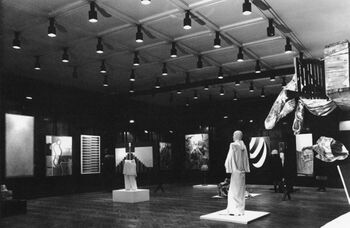Iparterv
Against the tide of György Aczél's rigid socialist cultural policy, and in line with the international trends of the time and the events of the Western art world, the two Iparterv exhibitions were organised by the art historian Péter Sinkovits in the downtown building of the Iparterv State Architectural Office. Bypassing the official censorship board, the first exhibition opened on 22 December 1968 and lasted only a few days. The show featured 11 young artists: Imre Bak, Krisztián Frey, Tamás Hencze, György Jovánovics, Ilona Keserü, Gyula Konkoly, László Lakner, Sándor Molnár, István Nádler, Ludmil Siskov and Endre Tót. The second Iparterv exhibition, which opened on 24 October 1969, included four more artists, András Baranyay, János Major, László Méhes and Tamás Szentjóby, as well as new tendencies. The neo-avant-garde artists presented at Iparterv I and II did not form a homogeneous group: the exhibitions represented the latest tendencies in both abstract and figurative art. At the same time, the "Iparterv phenomenon" stands for more than just two exhibitions: it marks a period as well as a broader intellectual scene. [1]
- Publications
- Dóra Hegyi, Zsuzsa László, "Iparterv actions and exhibitions", Parallel Chronologies, tranzit.org, n.d.
- Dávid Fehér, "Pop Beyond Pop. Some Exhibitions of the Hungarian “Iparterv-Circle”, in Art in Transfer in the Era of Pop: Curatorial Practices and Transnational Strategies, ed. Annika Öhrner, Stockholm: Södertörn University, 2017, pp 343-372. (English)
- Iparterv 50+. 1968/69 - 2019, ed. Viktória Popovics, Budapest: Ludwig Múzeum - Kortárs Művészeti Múzeum, 2019. Dávid Fehér's essay. Publisher. (Hungarian)/(English)
- Links
- Iparterv 50+, exhibition, Ludwig Múzeum, Budapest, 2019.
- Wikipedia-HU
